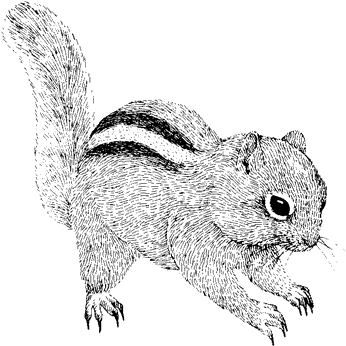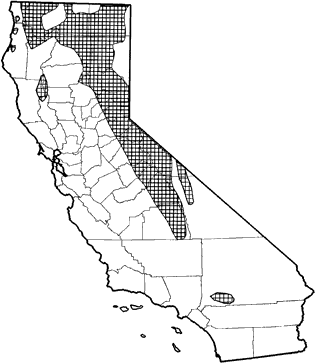
Golden-mantled Ground Squirrel
Distribution, Abundance, and Seasonality
Common and widespread, sometimes abundant, resident in openings and open stages of mixed conifer, ponderosa pine, Jeffrey pine, lodgepole pine, limber pine, pinyon-juniper, montane riparian, aspen, and alpine meadow edges of the Klamath, Cascade, and Sierra Nevada Ranges. Occurs locally in the North Coast and Transverse Ranges. In southern California, also found in chaparral. Has extended its range into areas opened by logging and developments, particularly in the western portion of the Klamath Range (Tevis 1956, Yocom and Eley 1972). Common in campgrounds and along roadways. Found at elevations from approximately 1500-3350 m (4875-11,000 ft).

Range Map
Specific Habitat Requirements
Feeding: Underground fungi and leaves of forbs may make up as much as 87% of the diet. They also eat pine nuts, seeds, flowers, bulbs, fruit, insects, and occasionally carrion and small vertebrates. Forage on the ground mostly, but will climb small bushes and trees, and will dig shallow holes to locate food. Apparently find underground fungi by scent. Carry food in cheek pouches to food caches.
Cover: Prefer open canopy without dense understory, with logs, stumps, talus, and other rocks for cover. Digs burrows, or may use pocket gopher burrows.
Reproduction: Nest in burrows, which often are placed under a rock or log. Nest lined with dried grass, leaves, or shredded bark.
Water: Will drink in captivity.
Pattern: Suitable habitat consists of open stands of montane forest without a dense understory. In the Blue Mts. of Oregon, the minimum area required to support a population of golden-mantled ground squirrels was estimated to be 16 ha (40 ac) (Thomas 1979).
Species Life History
Activity Patterns: Mostly diurnal, but may be active day and night in summer. Hibernate in areas where the ground freezes, or is covered with snow (Ingles 1965).
Seasonal Movements / Migration: Non-migratory.
Home Range: Home ranges mostly vary from 0.5 to 1 ha (1 to 2.5 ac). In ponderosa pine habitat in Arizona, Goodwin and Hungerford (1979) estimated densities at 1/1.6 ha (1/4 ac) in denser stands, and at 1/8.1 ha (1 /20 ac) in very open stands.
Territory: Territories include the burrow and about 30 m (100 ft) around the entrance (MacClintock 1970).
Reproduction: Copulation occurs from early March to May. Young are born from early April into early September, with most births occurring May to late June. Females produce 1 or 2 litters per yr with an average of 5 young (range 2-8). Gestation lasts 27-33 days, and young are weaned at 24-32 days. Males and females are sexually mature within the first yr.
Niche: Golden-mantled ground squirrels generally are benefitted by moderate timber harvest, which opens the canopy and allows greater production of food. Adults and young may be preyed upon by various diurnal and nocturnal raptors, and by snakes, martens, fishers, bobcats, foxes, and weasels. Competition for food may occur with other rodents that feed on forbs.
Sources & References
California Department of Fish and Game, 1999.
California's Wildlife, Sacramento, CA.
Written by: C. Polite, T. Harvey, reviewed by: M. White, edited by: G. Ahlborn
Carleton, W. M. 1966. Food habits of two sympatric Colorado sciurids. J. Mammal. 47:91- 103. Goodwin, J. G., Jr., and C. R. Hungerford. 1979. Rodent population densities and food habits in Arizona ponderosa pine forests. USDA, For. Serv., Rocky Mtn. For. and Range Exp. Sta. Res. Pap. RM-214. 12pp. Gordon, K. 1943. The natural history and behavior of the western chipmunk and the mantled ground squirrel. Oregon State Monogr. Studies in Zool. 5:1-104. Hatt, R. T. 1927. Notes on the ground squirrel Callospermophilus. Univ. Michigan, Mus. Zool. Occas. Pap. No. 185. 22pp. Ingles, L. G. 1965. Mammals of the Pacific states. Stanford Univ. Press, Stanford, CA. 506pp. MacClintock, D. 1970. Squirrels of North America. Van Nostrand Reinhold, New York. 184pp. McKeever, S. 1964. The biology of the golden-mantled ground squirrel. Ecol. Monogr. 34:383-401. Tevis, L., Jr. 1953. Stomach contents of chipmunks and mantled squirrels in northeastern California. J. Mammal. 34:316-324. Tevis, L., Jr. 1955. Observations on chipmunks and mantled squirrels in northeastern California. Am. Midl. Nat. 53:71-78. Tevis, L., Jr. 1956. Responses of small mammal populations to logging of Douglas-fir. J. Mammal. 37:189-196. Thomas, J. W., ed. 1979. Wildlife habitats in managed forests: the Blue Mountains of Oregon and Washington. USDA, For. Serv., Agric. Handb. No. 553. 512pp. Yocom, C. F., and T. Eley. 1972. Extension of golden-mantled ground squirrel range west to the Pacific coastal area of Humboldt and Del Norte counties, northwestern California. Murrelet 53:29-30.
California Animal Facts | California's Wildlife